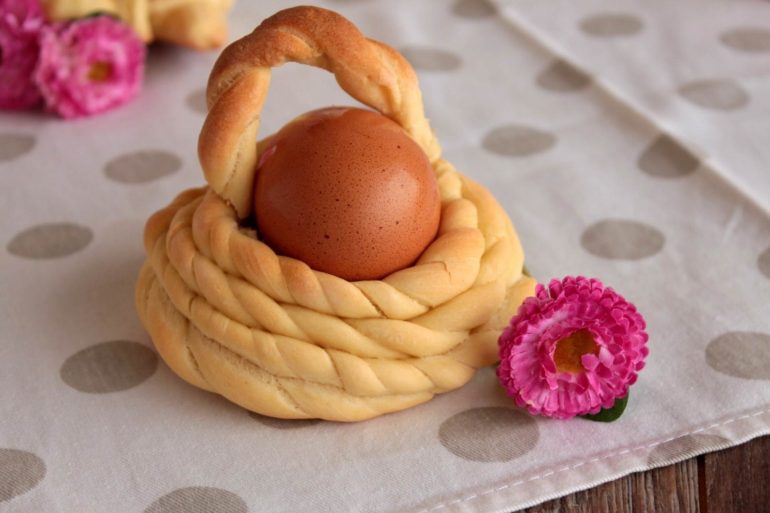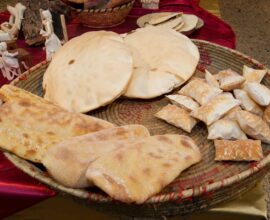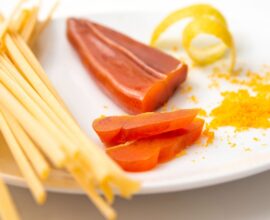Coccoi cun s’ou: Sardinia’s Easter traditional bread
The typical Easter bread in Sardinia
The great protagonist of the Easter holidays on the island, Coccoi cun s’ ou is the traditional Sardinian ritual bread.
Easter, Sa Pasca Manna, is the most beloved festival in Sardinia. It is celebrated throughout the island with touching rituals and processions as well as the pleasures and flavours of good food.
The great protagonist of the Easter table is a special ritual bread known as Coccoi cun s’ou or Bibilliu (and other variations according to location). This is made of durum wheat semolina and can be found in different sizes and shapes depending on the skills of the baker. It is finished with precious decorations and its main characteristic is a raw egg placed at its centre and left to cook along with the bread dough.
Crunchy on the outside and soft on the inside, it signifies abundance, luck for the future, affection and friendship and a demonstration of love.
The egg is the main symbol of the holiday as it represents the regeneration and the beginning of life. Easter on the island is linked to rebirth, fertility, the awakening of nature after winter rest and the hope of an abundant harvest.
When chocolate Easter eggs were not yet in vogue, children received as a gift this particular traditional bread in the most imaginative forms: dolls, chickens, birds and anything else suggested by inventiveness.
Tweezers, wheels, knives, and scissors help to decorate it according to an ancient and fascinating art.
Coccoi cun s’ou’s recipe
To prepare this typical Sardinian Easter bread, you’ll need 1 kilo of re-milled semolina, 1 stick of brewer’s yeast, water as needed and a teaspoon of salt.
In a bowl, pour the flour with the yeast dissolved in a little warm water and slowly add the remaining water and then the salt, working the mixture until it is compact and smooth.
Let it rise for about eight to ten hours and divide the dough into about ten pieces. Blanch the eggs for two minutes and let them cool.
With the loaves, crowns are formed and the egg is placed in the centre: the decorations are made according to the taste and imagination of the baker using wheels, scissors and a well-sharpened knife.
Once the bread is decorated, it should be placed in a baking pan and left to rise for an hour. Cooking takes place in a preheated oven at 200 degrees for 45/50 minutes.
As with many traditional Sardinian recipes, moving just a few kilometres can vary the ingredients and the name that is attributed to it.
A curiosity: in the past, the poorest families who could not afford eggs, made the Coccoi cun s’ou with almonds.
An Easter holiday dedicated to delicious traditional dishes and environmental sustainability
The Easter holidays are the perfect time to disconnect from daily commitments and enjoy the first trip of the year to find well-being, harmony and relaxation.
To celebrate the festival in a sustainable and environmentally friendly way and enjoy the authentic flavours of the Sardinian tradition, the ideal location is Forte Village, an elegant green resort. The affordable luxury hotels in Santa Margherita di Pula in the province of Cagliari, are homed in the unforgettable setting of a wonderful white beach caressed by the clear sea of Sardinia.
The award-winning resort boasts, in fact, a wide range of gourmet restaurants that know how to give an engaging sensory experience at every bite and satisfy every palate thanks to the delicacies of the best Italian and international chefs. Each dish is prepared with raw materials of the highest quality, in perfect balance between tradition, innovation and experimentation.
For the Easter holidays, Forte Village has thought of an exclusive holiday package for those who want to spend pleasant days enriched by a delicious menu with wonderful local, Italian and international selections. To balance, an amazing well-being offering in one of the most recognised thalasso & spa centres in the world and cutting-edge sports activities.
Would you like to taste Sardinian Easter’s traditional flavours and enjoy a fabulous holiday in an authentic paradise? Discover Forte Village Resort in Sardinia






